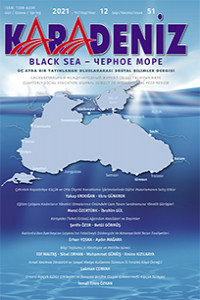Öz
The objective of the paper is an active application of the discussion method in the process of teaching the social sciences, with the focus on the subject of history that develops creative thinking, the intellectual and analytical capacity of students. The paper brings in focus the importance of using class discussion in active teaching since this method activates and maximally engages students in learning process. In the process of discussion, students develop their logical, critical and creative thinking, cognition as well as personal responsibility. The discussion stimulates an ability to substantiate the position or idea through healthy argument and judgment. It also supports the formation of democratic values among the students. It also encourages tolerance and understanding of opposite ideas. The discussion increases self-esteem and allows self-assertion. Application of discussion improves the ability of the students to conduct dialogue, express their ideas freely, provide argumentation in support of their position, cooperate, communicate, regulate conflict situations in interaction with peers and achieve consensus without confrontation.
Alongside the range of discussion forms, the objectives of the discussion method are also considered in the paper. The paper describes a comprehensive process of selection of the discussion topics, the question types used during the discussion as well as the procedures of leading the discussion. The role of a teacher to create a trustful, respectful, and healthy environment for the class discussion is well explained. In addition, the active and thematic planning of the discussion method in teaching different topics of History is comprehensively covered in the paper.
Anahtar Kelimeler
effective method of discussion building dialogue of culture teaching history via discussion method open and closed questions in discussion skills obtained by learners through discussion
Kaynakça
- Postman, N., (2007). “Ganatlebis mizani”, Tbilisi
- Swanson, D.R., (2009). ”Stsavlebis metodologiis sakhelmdzgvanelo”, Tbilisi
- Institute of Civil Development, (2012). “Critikuli da shemokmedebiti azrovneba, tsarmosakhviti ganaTleba”, Tbilisi
- National Assessment and Examination Center, (2010). “Efektiani stsavleba, teoria da praqtika”, Tbilisi
- Kennedy, J. F., (1963). https://www.jfklibrary.org/archives/other-resources/john-f-kennedy-speeches/berlin-w-germany-rudolph-wilde-platz-19630626
- Perkins, D., (2007).” Smart Schools Better Thinking and Learning for Every Child
- National Center for Teachers’ Professional Development, (2009). ”Efeqturi swavleba skolaSi”, Tbilisi
Öz
Целью статьи является активное применение дискуссионного метода в процессе преподавания общественных наук с акцентом на предмет истории, который развивает творческое мышление, интеллектуальные и аналитические способности студентов. В статье подчеркивается важность использования обсуждения в классе при активном обучении, поскольку этот метод активирует и максимально вовлекает учащихся в учебный процесс. В процессе обсуждения студенты развивают логическое, критическое и творческое мышление, познание, а также личную ответственность. Обсуждение стимулирует способность обосновать позицию или идею с помощью здоровых аргументов и суждений. Обсуждение также способствует терпимости и пониманию противоположных идей. Обсуждение повышает самооценку и позволяет самоутверждению. Оно также поддерживает формирование у студентов демократических ценностей. Применение обсуждения улучшает способность студентов вести диалог, свободно выражать свои идеи, аргументировать свою позицию, сотрудничать, общаться, регулировать конфликтные ситуации во взаимодействии со сверстниками и достигать консенсуса без конфронтации. Наряду с разнообразием форм обсуждения в статье рассматриваются также задачи метода обсуждения. В статье описывается комплексный процесс выбора темы для обсуждения, типы вопросов, используемые во время обсуждения, а также процедуры ведения обсуждения. Хорошо объяснена роль учителя в создании доверительной, уважительной и здоровой атмосферы для обсуждения в классе. Кроме того, в статье всесторонне освещаются активное и тематическое планирование дискуссионного метода при преподавании различных тем истории. Ключевые слова: эффективный метод обсуждения, построение культуры диалога.
Anahtar Kelimeler
эффективный метод обсуждения построение культури диалога преподавание истории через метод обсуждения открытые и закрытые вопросы в обсуждении навыки полученные студентами в ходе обсуждения
Kaynakça
- Postman, N., (2007). “Ganatlebis mizani”, Tbilisi
- Swanson, D.R., (2009). ”Stsavlebis metodologiis sakhelmdzgvanelo”, Tbilisi
- Institute of Civil Development, (2012). “Critikuli da shemokmedebiti azrovneba, tsarmosakhviti ganaTleba”, Tbilisi
- National Assessment and Examination Center, (2010). “Efektiani stsavleba, teoria da praqtika”, Tbilisi
- Kennedy, J. F., (1963). https://www.jfklibrary.org/archives/other-resources/john-f-kennedy-speeches/berlin-w-germany-rudolph-wilde-platz-19630626
- Perkins, D., (2007).” Smart Schools Better Thinking and Learning for Every Child
- National Center for Teachers’ Professional Development, (2009). ”Efeqturi swavleba skolaSi”, Tbilisi
Öz
Makalede, tarih konularına odaklandıklarında öğrencilerin: yaratıcı düşünme, düşünsel ve analitik yeteneklerini geliştiren sosyal bilimler öğretiminde kullanılan tartışma yöntemleri tetkik edilmiştir. Kullanılan yöntemlerin öğrenim sürecinde öğrenci katılımını etkilediğinden ve kalitesini artırdığından dolayı, aktif öğretimde konu üzerine sınıftaki tartışmaların önemine dikkat çekilmiştir.
Tartışma sırasında öğrencilerin mantıksal, eleştirisel, yaratıcı düşünme, bilgi ve kişisel sorumluluk yetenekleri gelişmektedir. Tartışma metodu mantıklı argümanlar ile yaklaşımlara dayalı olan bir tutumun öğrencilerde savunma yeteneklerini uyandırır. Tartışma aynı zamanda saygı ve karşıt fikirleri hoşgörü ile kabul etme davranışlarını da teşvik eder. Tartışma öğrencilerde özgüveni artırır, kendilerini ispatlamaya yol açar ve bununla birlikte öğrencilerde demokratik değerlere karşı saygı göstermeleri bilinci oluşturur. Tartışma metodu öğrencilerin diyaloga girme becerilerini geliştirir, fikirlerini özgürce ifade edebilme duygusunu geliştirir, kendi tutumlarını savunmakta, arkadaşlarıyla iş birliği yapmakta, iletişim kurmakta, gergin durumları düzenlemekte ve fikir birliğine varmakta yardımcı olur.
Makalede, tartışma biçimlerinin çeşitliliği yanı sıra tartışma yöntemlerini de ele alınmıştır. Burada tartışma konularının seçim süreci, tartışma sırasında kullanılan soru türleri ve tartışmayı yürütme yöntemleri, sınıftaki tartışma süresinde güvenilir, karşılıklı saygı ve sağlıklı bir ortam yaratmada öğretmenin rolü irdelenmiştir. Ayrıca makalede tarihin çeşitli konularını açıklarken tartışma yönteminin aktif ve tematik planlaması üzerine kapsamlı bir şekilde durulmuştur.
Anahtar Kelimeler
etkili tartışma yöntemi kültür diyaloğu oluşturma tartışma yöntemiyle tarih öğretimi tartışmada açık ve kapalı sorular öğrencilerin tartışma yoluyla edindiği beceriler
Kaynakça
- Postman, N., (2007). “Ganatlebis mizani”, Tbilisi
- Swanson, D.R., (2009). ”Stsavlebis metodologiis sakhelmdzgvanelo”, Tbilisi
- Institute of Civil Development, (2012). “Critikuli da shemokmedebiti azrovneba, tsarmosakhviti ganaTleba”, Tbilisi
- National Assessment and Examination Center, (2010). “Efektiani stsavleba, teoria da praqtika”, Tbilisi
- Kennedy, J. F., (1963). https://www.jfklibrary.org/archives/other-resources/john-f-kennedy-speeches/berlin-w-germany-rudolph-wilde-platz-19630626
- Perkins, D., (2007).” Smart Schools Better Thinking and Learning for Every Child
- National Center for Teachers’ Professional Development, (2009). ”Efeqturi swavleba skolaSi”, Tbilisi
Ayrıntılar
| Birincil Dil | İngilizce |
|---|---|
| Konular | Alan Eğitimleri |
| Bölüm | Araştırma Makalesi |
| Yazarlar | |
| Yayımlanma Tarihi | 30 Eylül 2021 |
| Gönderilme Tarihi | 2 Temmuz 2021 |
| Yayımlandığı Sayı | Yıl 2021 Sayı: 51 |

